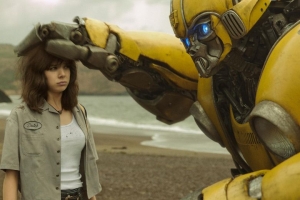
The Transformers were kid toys; they were literally meant to be played by children. You wouldn’t know it, though, based on the previous decade of movies: long, ponderous, grim, unintelligible, and so, so boring. In recent years, the Michael Bay Transformers movies have become every cinema geek’s go-to punching bag and for good reason. They’re really, really fucking terrible. But beyond all the poor directing choices, bad acting, and everything else, the movies seemed to possess a fundamental misunderstanding of who exactly the movies were supposed to be for. This fundamental identity crisis is just one of the many things Travis Knight’s Bumblebee rectifies.
Set in loose continuity with the other movies (meaning thankfully that seeing the others before this one is not at all necessary), the movie opens on Cybertron for an opening battle that – gasp, shock – I could actually see. Already, this was a damn game changer for the Transformers franchise. From there, we move to 1987s California, where an escaping Bumblebee meets up with Charlie Watson (Hailee Steinfeld), a teenager still smarting from the death of her father. Bumblebee has fled to Earth on orders from Optimus Prime, leader of the Autobot resistance, with a mission: protect the planet until further Transformer backup can arrive. Unfortunately, two Decepticon villains have traced his signal back to Earth and have teamed up with the military to take Bumblebee down. Further complicating matters, Bumblebee has lost both his memory and his voice. Will Charlie and Bumblebee be able to overcome their obstacles and save the world?
First off, this movie is fun. It is really, really fun in a way that Transformers movies haven’t been in a very long time. It’s a movie that completely understands that it’s about a robot that can turn into a car and shoot missiles. One of the Decepticons has a liquifier gun! A gun that liquifies! But the action isn’t centered around robot wars. For me, the best parts of the movie were the more low-key moments, when it became an Iron Giant-like story about a girl and her robot friend, just living their lives. This is a very low stakes movie for most of its running time, which was absolutely the right choice. Over the course of its 114 minutes, I got to know both Bumblebee and Charlie pretty well, which meant that by the time the fireworks factory opened its doors for the climax, I actually cared about what was happening.
Also, the action in this movie is very well done. Gone are the nausea-inducing clusterfucks of old, where you occasionally got a clear glimpse of Optimus Prime’s elbow (but really, it could be anyone’s). Travis Knight, in his second feature after Kubo and the Two Strings, knows exactly where to place the camera for maximum effect, getting everything into frame and making sure the punches have impact. The climax is legitimately thrilling, never descending into “two CGI things punch each other for 1,000 minutes”, but instead relying on both Charlie and Bumblebee to use their wits to defeat the menace.
For all that, the movie is not without fault. It’s a little too similar to The Iron Giant, for one thing, with shades of E.T. thrown in there for good measure, and this movie can’t help but pale in comparison to both. Some of the scenes are a little too rote, and while the movie is a deliberate throwback, that doesn’t stop it from occasionally feeling a tad too familiar. Love Simon’s Jorge Lendeborg Jr. gets too little to do as the love interest, Charlie’s family disappear from the movie for long stretches at a time, and John Cena’s character only has an emotional arc by virtue of John Cena giving it his all, performance wise. The script kind of leaves him out to dry.
But while watching Bumblebee, none of that occurred to me. I was hopeful a directing change would imbue new life into this franchise, and it’s always nice to be proven right.
